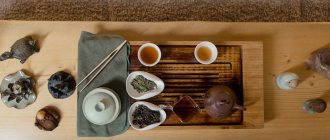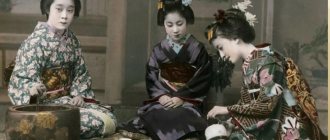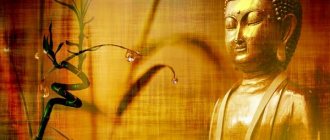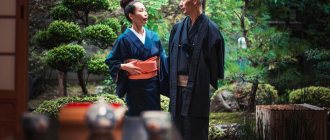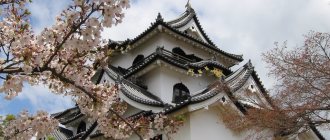Japanese tea ceremony.
Japanese tea ceremony Cha-no-Yu
The name of the man who introduced the concept of the tea ceremony in the country is Murata Juko. He is credited with creating the rules, traditions and behavior during the ceremony.
Sa-do
The Way of Tea
The four most important principles are like four pillars on which the whole action rests: harmony – “wa”, respect – “kei”, purity – “sei”, silence – “seki”.
The Japanese tea ceremony can take place: at night (from 12 to 4 am); at sunrise (from 3-4 o'clock); in the morning (from 6 o'clock); after lunch (from 13 o'clock). There is also a special tea ceremony in Japan. The time of its implementation is determined specifically, because it is associated with unusual reasons: holidays; special events; meeting friends. In former times, a special tea ceremony could become a kind of preparation for battle, ritual suicide.
The main purpose of tea drinking was moral support and affirmation of a person’s spiritual strength.
The initiator of the meeting - the owner of the ceremony - chajin - calls the guests a few days before the event, prepares a Japanese set, which includes a cauldron, teapot, bowls, tea, etc. Also in the tea room, a corner with paintings and paintings is prepared for aesthetic ecstasy (tokonoma) .
When organizing a tea ceremony in Japan, great attention is paid to the tea garden. The garden has a lot of evergreen shrubs, flowers, cypresses, pines, and bamboo. Stone lanterns are installed as attributes, and ordinary stones, covered with moss from time to time, are casually scattered. All this is done so that here, in nature, a person can fully concentrate on the inner world, immerse himself in a state of detachment, as if he had become a hermit.
A stone path - roji - runs through the tea garden. All guests walk along it to the tea house - chashitsu. The first tea house was invented and built in 1473. The entrance to the tea house is designed in such a way that absolutely anyone who comes bows, whether you like it or not, the dimensions of the entrance opening are only 60x60 cm. The idea here is that regardless of rank, position and class affiliation, you must bow, because everyone here is equal. It is not allowed to enter with weapons or any objects.
The art of the tea ceremony in Japan consists of complete solitude from worldly worries and problems; a person is immersed in a special “enlightened solitude.”
Questions: 1. What was the name of the person who introduced the concept of the tea ceremony? 2. What are the 4 main principles of the tea ceremony? 3. What is the name of the host of the tea ceremony? 4. What is the name of the special corner with painting? 5. What do the Japanese call the way of tea?
Conducting a tea ceremony in Japan, presentation for a lesson (geography, grade 10) on the topic
Scenario for a Japanese tea ceremony. (Grade 10)
Goal: to introduce students to the tradition of the Japanese tea ceremony; introduce the concepts of “tokonoma”, “kaiseki”, “amogashi”; develop cognitive, educational and creative activities; to cultivate in students an interest in the traditions of foreign Asian countries.
Presentation. 1 slide
Conducting a tea ceremony in Japan is a strictly practiced ritual - a process in which every movement of the body, words, mood and thoughts must have a certain meaning and philosophy. The philosophy of this ritual is the desire for simplicity, naturalness and harmony of body, spirit and nature.
The tea ceremony has many stages and rituals.
Now we will present you with a short description of such stages. It is possible that from some of the rituals you will be able to take note of interesting facts and tips that you can later apply at your own tea ceremony.
Probably, some of you, dear guests, have already asked the question: why is this special tea ceremony needed and isn’t it possible to just brew a tea bag in any mug and drink it? Of course you can, but there will always be moments when you want something special, new and beautiful. Especially if it concerns holidays, receiving guests, or you just want to relax on an ordinary day. It is this knowledge of Japanese traditions that will help you make an impression and leave unforgettable memories.
And so, let's start with the features and stages of the traditional tea ceremony in Japan!
The tea ceremony is held by the host for invited guests at his home. The ceremony itself takes place in a specially designated and adapted place. Before the ceremony, all guests gather in one room, where they are served hot water in small cups. The purpose of this stage is to create a general mood for the guests to perceive beauty.
Afterwards, guests head through the garden to the tea house. 2 slide. At the same time, the passage through the tea garden along the stone-lined path 3 slide is very important, as it symbolizes removal from the hustle and bustle and everyday life, detachment from everyday worries, anxieties and troubles. Contemplating the plants and stones of the garden, guests tune in to concentration and clear their minds of unnecessary things.
At the end of the path in front of the tea house, the owner greets the guests. After a small handshake, guests approach the stone well and perform the rite of ablution. Water is scooped up with a small ladle on a long wooden handle, while the guest washes his hands, face, rinses his mouth, and also washes the handle of the ladle after himself. The ritual of ablution symbolizes bodily and spiritual purity.
After bathing, guests go to the tea house. Passing through the low and narrow entrance symbolizes the final exit beyond the boundaries of the ordinary world. The inconvenience of entry and the need to bend low when entering a tea house symbolize the equality of participants in the ceremony - everyone is forced to bow, regardless of nobility, wealth, fame and social status. When entering the tea house, guests leave their shoes at the doorstep.
When the guests arrive, the fire in the hearth is already burning, a cauldron of water is standing over the fire. Upon entering the house, the guest first of all pays attention to the niche opposite the entrance - the tokonoma. Before guests arrive, the owner hangs a scroll with a saying there (slide 4), and also places a bouquet of flowers and an incense burner. The saying defines the theme of the ceremony and reflects the state of mind of the host. The owner enters the tea house last, some time after the guests, to give the guests the opportunity to examine and evaluate the items in the tokonoma without haste.
Upon entering the house, the owner bows to the guests and takes his place - opposite the guests, near the hearth. Near the owner's place are the necessary items for making tea. While the water in the cauldron is heating up, guests are served kaiseki - a light meal consisting of simple, not filling, but delicious dishes designed not to fill you up, but to relieve the discomfort caused by hunger. The Japanese believe that food served with tea should, first of all, be pleasing to the eye, and only secondarily satiating. The name "kaiseki" comes from a hot stone that in the past, Zen monks kept in their bosoms to quell hunger. Lastly, “omogashi” - sweets for tea - are served.
After the kaiseki, guests leave the tea house for a while, stretch their legs and prepare for the main part of the ceremony - drinking thick tea together. At this time, the owner changes the scroll in the tokonoma to a chabana - a composition of flowers and/or branches, which is compiled according to the principle of unity of contrasts, it can be a pine branch, as a symbol of strength and durability, and a camellia flower, symbolizing tenderness in a flower bouquet.
The most important part of the ceremony is (5 slide) preparing and drinking thick green tea powder. The guests gather again in the tea house, where the owner begins to prepare tea. The entire process takes place in complete silence. Everyone carefully watches the actions of the owner and listens to the sounds of fire, boiling water, streams of steam from the boiler, to which are later added the quiet sounds produced by the owner’s manipulations with the bowl, tea and dishes. The owner first carries out a symbolic cleansing of all used utensils, and then begins to prepare tea. All movements in this process are strictly verified and practiced, the owner moves in time with his breathing, the guests carefully watch all his actions. This is the most meditative part of the ceremony. The tea is poured into a rough ceramic bowl, a small amount of boiling water is poured into it, the contents of the bowl are stirred with a bamboo stirrer until it turns into a homogeneous mass and a green matte foam appears. Then more boiling water is added to the bowl to bring the tea to the desired consistency. (6 slide)
The host bows to the guests with a cup of prepared tea, traditionally in order of seniority, starting with the eldest or most honored guest. The guest places a silk scarf (fukusa) on his left palm, accepts the cup with his right hand, places it on his left palm and, nodding to the next guest in order, drinks from the cup. Then he places the fucus on the mat, wipes the edge of the bowl with a paper napkin and passes the bowl to the next one. Each guest repeats the same procedure, after which the bowl is returned to the owner.
Drinking tea from a common cup symbolizes the unity of the gathered guests. After the bowl has passed around all the guests, the owner again hands it over to the guests, now empty, so that everyone can carefully examine the bowl, evaluate its shape, and feel it in their hand again.
From this moment, the next stage of the ceremony begins - the owner prepares light tea in a separate cup for each of the guests. The conversation begins. This part of the ceremony is a rest, during which they do not talk about business and everyday worries. The subject of discussion is the tokonoma scroll, the saying written on it, the beauty of the flower arrangement, the bowl, other utensils and the tea itself. Immediately before tea is served, guests are served sweets. At the end of this part of the ceremony, guests are again invited to examine the utensils used to prepare the tea.
At the end of the conversation, the owner, having answered all the guests’ questions, apologizes and leaves the tea house, thereby indicating that the ceremony has come to an end. In the absence of the host, the guests examine the hearth on which the tea was prepared and once again pay attention to the flowers in the tokonoma, which should open by the time the ceremony is completed. The opened flowers serve as a reminder of the time spent together by the ceremony participants.
While the guests are leaving the tea house, the owner is close to its entrance, silently bowing to those leaving. After the guests leave, the owner sits for some time in the tea house, remembering the past ceremony and recalling the remaining sensations from it. Then he takes away all the dishes, puts away the flowers, wipes the tatami in the house and leaves. Cleaning symbolizes summing up the final outcome of the action that took place. The tea house is returned to the same state it was in before the ceremony. It is considered important that the action, without leaving any external traces, was preserved only as a trace in the minds of the people who participated in it. (7 slide)
For tea to reveal all its properties, surrounding objects must please the eye, and gentle music must delight the ear. Forget about the rush for a while, listen to yourself, give your body and spirit a feeling of harmony. Traditional music of Japan and China. The tradition of tea drinking has existed for five thousand years. The tea ceremony allows you to enjoy all the jewels of tea: the shape of the leaf, the color of the infusion, the refined aroma and exquisite taste, it fills the body with energy and increases vitality.
Now you know what a tea ceremony is. Of course, it will be difficult to hold a real tea ceremony at home, but we have prepared reminders for you as a gift that will help you surprise your guests and make a simple tea party amazing and unforgettable.
Memo as a gift.
We wish your tea ceremony to bring you and your guests pleasure and a lot of good impressions! Some tips:
- Be ready by the time the guests arrive. Don't make them wait and feel uncomfortable.
- If the guests do not know each other, then include in your ceremony plan a stage where the guests get to know each other and relax.
- Prepare a change of shoes for each guest or warn them to bring their own. Often there are not enough replacement shoes for all the guests, and the guests feel awkward.
- Create a beneficial atmosphere at home. Play appropriate music and place snacks on the table to make guests relax and feel at home. Music will help drown out the silence that arises from silence and embarrassment of guests to talk to each other.
- You must have a strict number of seating arrangements at home. Also, in the modern world, it would be incorrect to seat guests depending on their social status, so give guests the right to choose where they sit.
- It is important that guests are seen and felt welcome. So be open and caring.
The material was prepared and taught by Inga Vladimirovna Lysyakova, a geography teacher at the Svetlovsk Secondary School.

